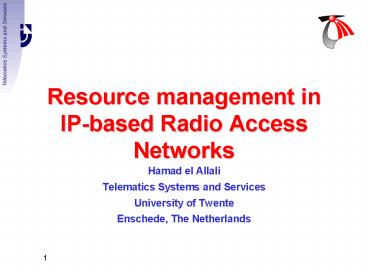Resource management in IPbased Radio Access Networks
1 / 14
Title:
Resource management in IPbased Radio Access Networks
Description:
To guarantee QoS in the network, adequate resources must be ... Ingress router. Call. request. Load control characteristics: Simple. Scalable. High utilization ... –
Number of Views:28
Avg rating:3.0/5.0
Title: Resource management in IPbased Radio Access Networks
1
Resource management in IP-based Radio Access
Networks
- Hamad el Allali
- Telematics Systems and Services
- University of Twente
- Enschede, The Netherlands
2
Contents
- Introduction
- UMTS
- Radio Access Network
- Resource reservation in IP networks
- Integrated Services
- Differentiated Services
- Admission Control
- IP-based RAN
- Load control
- Measurement strategy
- Conclusion and future work
3
IntroductionUMTS
Peak rates 64,144, 384, 2048 Kbps
UTRAN
PSTN
BS
Core Network
RNC
Internet
MT
BS
Services - Telephony - Mobile Internet access -
Multi-media applications
4
Introduction Radio Access Network
Current RAN - Consists of thousands of BSs - BSs
interconnected with ATM VCs
RNC
Link with 6 VCs
CN
Disadvantages of ATM in RAN - Needs management
to setup and maintain VCs - High transmission
costs
5
Introduction Radio Access Network
Advantages of IP - Cost reduction of
transmission network. - No signaling needed any
more - Flexible and efficient connectivity -
Easier management - Efficient Internet access
RNC
CN
6
Resource reservation in IP networks
To guarantee QoS in the network, adequate
resources must be reserved
- IETF developed several frameworks to reserve
resources - Integrated Services
- Differentiated Services
7
Integrated Services
RSVP cloud
- Intserv characteristics
- - Lack of scalability
- per flow scheduling and buffer management
- maintain per flow state, RSVP signaling
- End-to-end QoS
8
Differentiated Services
Edge routers mark packets and enforce the
service profile in SLA at the network boundary
Diffserv characteristics Not per flow
management Complex functions at the edge
Services defined with PHB - Not end-to-end QoS
Core routers differentiate packets based on
packet marking
9
Admission Control
Admit only if new flow active flowslt link
capacity
Goal To avoid network congestion, such that QoS
requirements of accepted calls can be
guaranteed.
10
Resource reservation in IP-based RANs
- RAN requirements
- Appropriate QoS for real-time traffic
- Minimal complexity
- Efficient network utilization
- Fast call set-up times
Load control is based on diffserv and AC and is
therefore promising
11
Load control
Call request
Egress router
- Load control characteristics
- Simple
- Scalable
- High utilization
Ingress router
Goal Probing the path for resources and perform
admission control.
12
Measurement strategy
13
Conclusions
- Load control is promising for resource
reservation in IP-based RAN. - We propose to enhance load control with MBAC
because of the utilization performance.
14
Future work
- Design of mechanisms for load control with MBAC
in RAN environment. - Performance analysis of load control with MBAC in
RAN environment. - Experimental verification of ideas by
implementing enhanced load control in a Diffserv
testbed.































